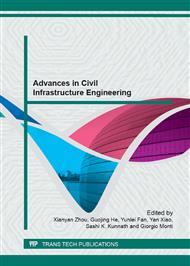[1]
Ertin E, Potter L C, Polarimetric classification of scattering centers using M-ary Bayesian decision rules, IEEE Trans. on Aerospace and Electronic System, 36(2000) 738-749.
DOI: 10.1109/7.869492
Google Scholar
[2]
Kouskoulas Y, Ulaby F T, Pierce L E., The Bayesian hierarchical classifier(BHC) and its application to short vegetation using multifrequency polarimetric SAR, IEEE Trans. on Geoscience and Remote Sensing, 42(2004):469-477.
DOI: 10.1109/tgrs.2003.821066
Google Scholar
[3]
Hellmann M, Jager G, Kratzschmar E, Habermeyer M, Classification of full polarimetric SAR-data using artificial neural networks and fuzzy algorithms, in Proceedings of IEEE International Geosience and Remote Sensing Symposium, 1999: 1995-1997.
DOI: 10.1109/igarss.1999.775011
Google Scholar
[4]
Chen C T, Chen K S, Lee J S, The use of fully polarimetric information for the fuzzy neural classification of SAR images, IEEE Trans. on Geoscience and Remote Sensing, 41(2003) 2089-2100.
DOI: 10.1109/tgrs.2003.813494
Google Scholar
[5]
Fukuda S, Hirosawa H, A wavelet-based texture feature set applied to classification of multifrequency polarimetric SAR images, IEEE Trans. on Geoscience and Remote Sensing, 37(1999) 2282-2286.
DOI: 10.1109/36.789624
Google Scholar
[6]
Aiazzi B, Alparone L, Baronti S, Garzelli A, Land cover classification of built-up areas through enhanced fuzzy nearest-mean reclustering of textural features from X- and C-band polarimetric SAR data, in Proceedings of SPIE, 2004: 105-115.
DOI: 10.1117/12.514258
Google Scholar
[7]
Lin C, Wang S, Fuzzy support vector machines, IEEE Transaction on Neural Networks, 13(2002) 464-471.
DOI: 10.1109/72.991432
Google Scholar
[8]
Cloude, S.R. and Pottier, E., A review of target decomposition theorems in radar polarimetry, IEEE Transactions on Geoscience and Remote Sensing, 34(1996) 498-518.
DOI: 10.1109/36.485127
Google Scholar
[9]
Fang Cao, Wen Hong, Yirong Wu and Eric Pottier, An unsupervised segmentation with an adaptive number of clusters using the SPAN/H//A space and complex Wishart clustering foe fully Polarimetric SAR data analysis, IEEE Transactions on Geoscience and Remote Sensing, 45(2007):3454-3467.
DOI: 10.1109/tgrs.2007.907601
Google Scholar
[10]
Tai-Yue Wang, Huei-Ming Chiang, Fuzzy support vector machine for multi-class text categorization, Information Processing and Management, 43:914-292, 2007.
DOI: 10.1016/j.ipm.2006.09.011
Google Scholar
[11]
Rukshan Batuwita, Vasile Palade, FSVM-CIL:Fuzzy support vector machines for class imbalance learning, IEEE Transactions on Fuzzy Systems, 18(2010558-571.
DOI: 10.1109/tfuzz.2010.2042721
Google Scholar


